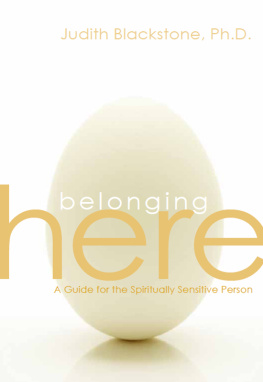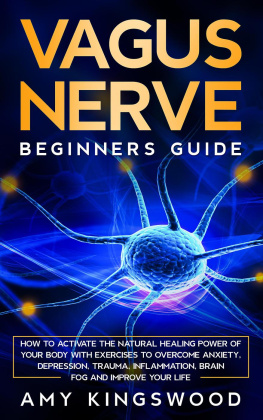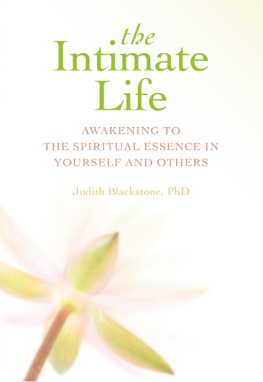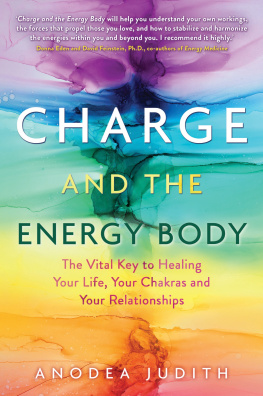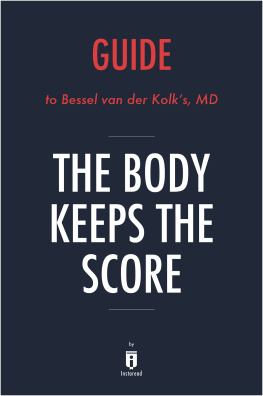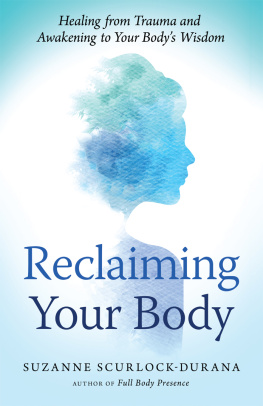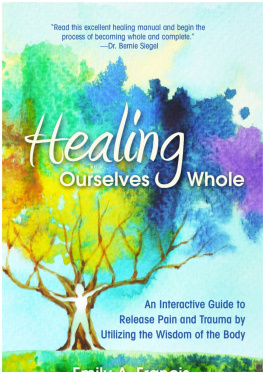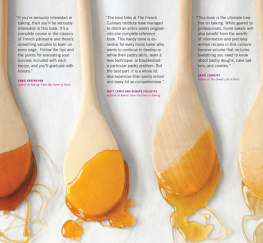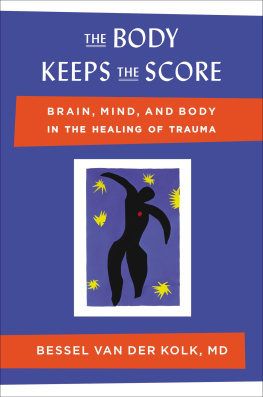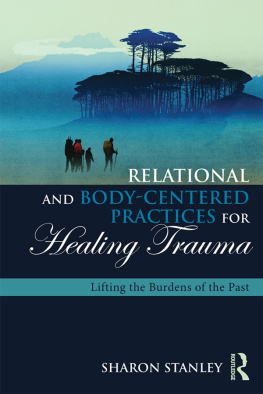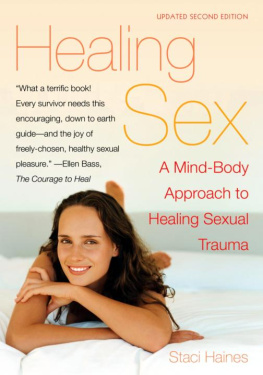Judith Blackstone - Trauma and the Unbound Body: The Healing Power of Fundamental Consciousness
Here you can read online Judith Blackstone - Trauma and the Unbound Body: The Healing Power of Fundamental Consciousness full text of the book (entire story) in english for free. Download pdf and epub, get meaning, cover and reviews about this ebook. year: 2018, publisher: Sounds True, genre: Science. Description of the work, (preface) as well as reviews are available. Best literature library LitArk.com created for fans of good reading and offers a wide selection of genres:
Romance novel
Science fiction
Adventure
Detective
Science
History
Home and family
Prose
Art
Politics
Computer
Non-fiction
Religion
Business
Children
Humor
Choose a favorite category and find really read worthwhile books. Enjoy immersion in the world of imagination, feel the emotions of the characters or learn something new for yourself, make an fascinating discovery.
- Book:Trauma and the Unbound Body: The Healing Power of Fundamental Consciousness
- Author:
- Publisher:Sounds True
- Genre:
- Year:2018
- Rating:4 / 5
- Favourites:Add to favourites
- Your mark:
- 80
- 1
- 2
- 3
- 4
- 5
Trauma and the Unbound Body: The Healing Power of Fundamental Consciousness: summary, description and annotation
We offer to read an annotation, description, summary or preface (depends on what the author of the book "Trauma and the Unbound Body: The Healing Power of Fundamental Consciousness" wrote himself). If you haven't found the necessary information about the book — write in the comments, we will try to find it.
Trauma and the Unbound Body: The Healing Power of Fundamental Consciousness — read online for free the complete book (whole text) full work
Below is the text of the book, divided by pages. System saving the place of the last page read, allows you to conveniently read the book "Trauma and the Unbound Body: The Healing Power of Fundamental Consciousness" online for free, without having to search again every time where you left off. Put a bookmark, and you can go to the page where you finished reading at any time.
Font size:
Interval:
Bookmark:

CONTENTS
INTRODUCTION
THE UNDIVIDED LIGHT
To know all things, including the painful and difficult, are lit from within by undivided light.
AURA GLASER
W holeness is not a vague ideal, but a lived experience. It is a potential, inherent in our human nature. To be whole is to be conscious and in contact with ourselves everywhere in our body, to live within our body. When we inhabit our body, we experience ourselves as an undivided consciousness, a subtle, unified ground of consciousness, pervading our whole body and our environment, at the same time.
This book offers a method, called the Realization Process, of understanding and healing trauma. To heal means to become whole. Trauma fragments and limits our wholeness. In the following chapters, I will show how trauma separates us from our body, how it disrupts the unity of body and mind and the oneness of self and other, and how we can resolve this separation.
When we embody our wholeness, our thoughts, emotions, sensations, and perceptions occur as a unity. Our senses function as a unity. Our actions spring from a single source of understanding, emotion, and physical sensation. Even the smallest movement of our body, as we turn our head or gesture with our hands, carries the full breadth of our human capacities. So, for example, we can experience love and intelligence in our arms or our legs; we can hear with our whole body, heart, and mind.
To be in contact internally with our body is, at the same time, to be open to our environment. Everywhere that we are in contact with ourselves within our body, we are alive and responsive to the world around us. This produces a lived experience of continuity and connection with everything and everyone that we encounter.
Yet, even though this fundamental, unified ground of our being is right here, as simple to reach as living within our own body, most human beings never experience it. Even though our basic nature is wholeness, somehow we become divided. This is because the traumatic events that occur in all human lives cause us to fragment and diminish our ability to live fully within our body.
There are two categories of trauma: extreme events, such as severe injury or abuse, that impact us with great force, and relational trauma that everyone faces, especially in childhood, when ordinary events are too abrasive or confusing for us to fully absorb them. In general, relational trauma consists of small painful events that are repeated over time, while extreme trauma can occur just once in order to have a lasting impact on us. Both types of trauma have a shattering effect on us. In reaction to traumatic events, both big and small, we constrict and fragment our body and withdraw our consciousness from those parts of our body. We organize ourselves in ways that dampen the impact of intolerable experience or that restrain those aspects of our own behavior and personality that have brought us harm.
We can probably all understand how being held down and sexually assaulted or severely beaten by a gang of assailants on the street can have a lasting effect on our psychological state. It may not be so easy to grasp that ordinary, seemingly insignificant events, especially when we are very young, can impact our experience for the rest of our lives.
Here is an example. An infant is nursing at her mothers breast, and then, feeling contentedly sated, pulls away from the breast and begins to drift into sleep. But abruptly she is woken by the anxious mother forcing her breast into her mouth, compelling her not only to swallow the unwanted milk, but also to absorb the mothers anxiety about feeding her new baby and the sense of rejection and abandonment that the mother felt when her baby pulled away. We can see that there is no blame here. The mother is mal-attuned, but her anxiety, even her sense of rejection, are understandably human. However, in an attempt to keep out the unwanted milk, the baby naturally tightens her throat. She may even constrict her chest in order not to feel the mothers emotional upset. These are natural, spontaneous movements of protection against unpleasantness and overwhelm. However, if these tense, mal-attuned feeding events are repeated over time, the infants protective patterns will become chronic tensions in her throat and chest. As she gets older, feeding may become increasingly fraught, due to the pattern of tension in her throat and her associations of emotional upset with taking in food. When she grows up, this tension may still affect her eating habits. She may feel some vague, apparently inexplicable anxiety at mealtimes. She may even experience another persons attempts at affection as intrusive. She may also harbor a static, background belief about herself that she has done something wrong or hurt someone in some way that she cannot clearly point to but that nevertheless leaves her feeling not quite innocent.
These patterns of constriction and belief form throughout childhood, in relation to our immediate family and to our peers at school. We also constrict ourselves in reaction to abrasive sensory stimuli in our environment. The constant presence of cigarette smoke in our childhood home may cause us to inhibit our breathing; the persistent racket of traffic or passing trains may cause us to impede our hearing.
Although most relational trauma occurs in childhood when we have less perspective with which to assimilate events and less freedom to leave traumatic circumstances, as adults, we can also be traumatized by ongoing abusive relationships or by overwhelmingly painful events. Someone who is consistently denigrated, for example, by a spouse or a boss at work may react in the same way as a child does to an abusive sibling or adult, by forming lasting beliefs about themselves and others and creating chronic bodily patterns of constriction that express these negative beliefs or that protect against the full impact of the abuse.
Because children also mirror the patterns of constriction in their parents bodies, we embody not only our reactions to our own trauma, but we take on some of our ancestors reactions to their trauma as well. This is one of the ways in which trauma is passed down from one generation to the next.
Our history of trauma, bound within our body, may haunt our present life as chronic feelings of sadness or despair, as distracting bouts of fury, or as spells of terror. But it can also be present as numbness, as a chronic static in our perception, as if we were always slightly removed from ourselves and our surroundings. This pain, whether it be conscious suffering or that slight sense of unreality, is often mistaken for our basic nature, something we just need to shoulder or ignore in order to move on. But it is not our basic nature. Just as an open hand is hidden within a fist, our true nature, with its innate capacities for happiness, love, and wisdom, is hidden within our pain and numbness. Just as we can open a fist to reveal a hand, our unbound, unconstructed being can emerge from our pain and breathe again. Within the complexity of trauma-based beliefs and constrictions, we can find our unbound body and the wholeness that is our birthright. We can experience ourselves as the one light, the undivided consciousness, that is the ground of our being and of all being.
A Process for Healing and Wholeness
The Realization Process is a series of practices that I have developed and taught over the past four decades. Its effectiveness has been proven to me consistently over this time, both in its application to my own healing and to the healing of the many people who have come to work with me. These practices approach the healing of trauma in two ways. There are practices that directly facilitate body-mind integration through inhabiting the internal space of ones body, attuning to the unified ground of fundamental consciousness and the inherent qualities of ones being that emerge as we know ourselves as this ground. And there are practices that utilize our attunement to fundamental consciousness in order to precisely and lastingly release the trauma-based constrictions in the body. This release, in turn, enables us to more fully inhabit the body so as to become more whole within ourselves and more open to our environment.
Next pageFont size:
Interval:
Bookmark:
Similar books «Trauma and the Unbound Body: The Healing Power of Fundamental Consciousness»
Look at similar books to Trauma and the Unbound Body: The Healing Power of Fundamental Consciousness. We have selected literature similar in name and meaning in the hope of providing readers with more options to find new, interesting, not yet read works.
Discussion, reviews of the book Trauma and the Unbound Body: The Healing Power of Fundamental Consciousness and just readers' own opinions. Leave your comments, write what you think about the work, its meaning or the main characters. Specify what exactly you liked and what you didn't like, and why you think so.


